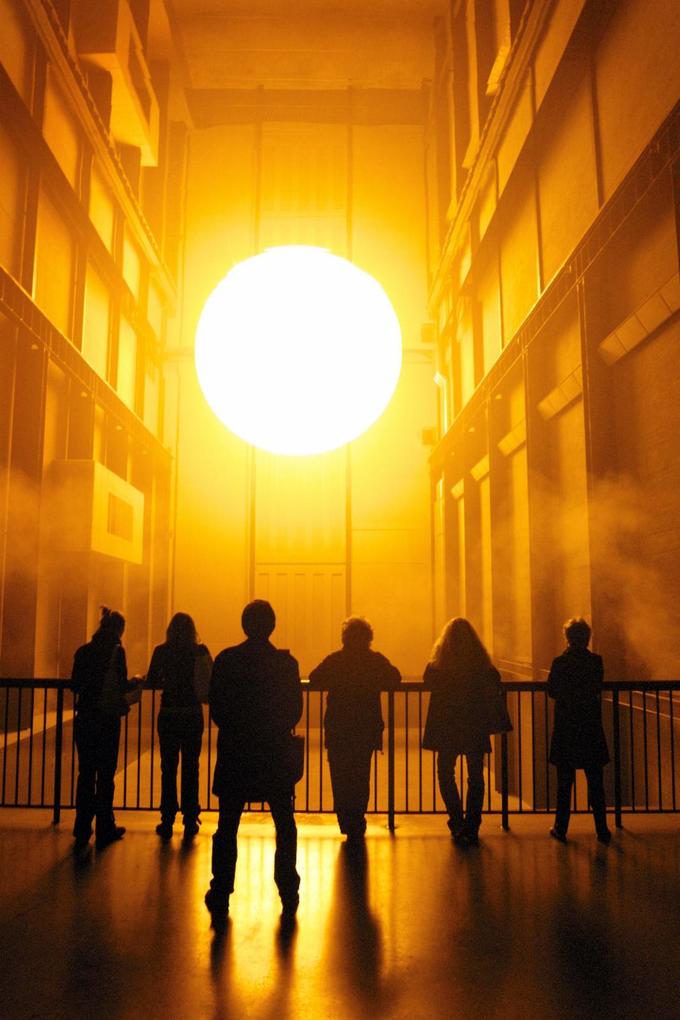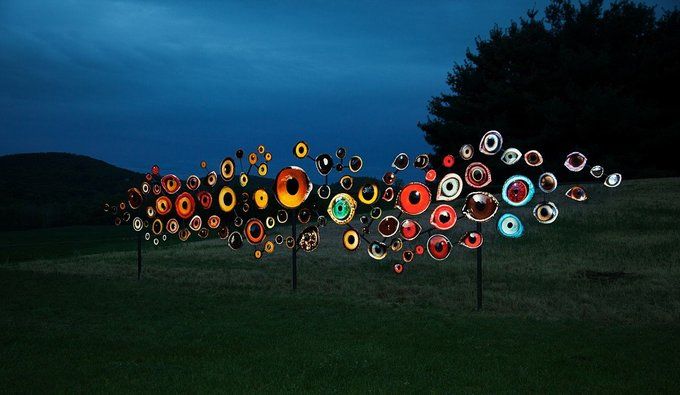Globally, more and more creatives are using art as a form of activism and striving to raise awareness about rising sea levels, increasing temperatures, deforestation, plastic pollution, and more. From creating with recycled materials to, quite literally, making art from trash, here we take a closer look at the environmentalists offering an acute commentary on the climate crisis.
Read our guide and discover leading contemporary painters, printmakers, sculptors and installation artists creating work that confronts climate change.
From Art to Activism
From Gavin Turk and his bronze recyclables to Olafur Eliasson, who brought the melting arctic to our doorsteps, contemporary art continues to vehicle social purpose and change. Here are nine contemporary artists using their work and platform to advance environmental issues.
Tan Zi Xi
Singaporean artist Tan Zi Xi, also known as MessyMsxi, creates playful yet sharp collections that expose the realities of ocean pollution. Tan Zi Xi collected, cleaned and organised 500kg of discarded ocean plastic (over 26,000 pieces) to create her Plastic Ocean installation. The experiential exhibition, consisting of plastic detritus hanging motionless in space, seeks to illustrate how our global marine landscapes are being suffocated by plastic waste. Spectators who ventured into the ‘underwater’ realm were able to experience what plastic pollution looks like from the perspective of life forms who call the ocean home. With some plastics taking over 1,000 years to decompose, Tan Zi Xi’s unsettling display presents a microcosm of the future state of our oceans if we do not act now.

Plastic Ocean, 2016, by Tan Zi Xi (courtesy of Oceanic Global)
Gavin Turk
Conceptual artist Gavin Turk reimagines the purpose of disposable objects. Nicknamed “the laureate of waste” by the Financial Times, Gavin utilises throwaway items to comment on society’s relationship with waste and worth. Themes of repurposing or redirecting weave between Gavin’s works which explore the transformational power of recycling. Creatively: experimenting with unique modes of art. And, practically: spotlighting the nefarious nature of mass production and consumption.

Pile, 2004, by Gavin Turk (courtesy of the artist)
Andy Goldsworthy
Andy Goldsworthy produces site-specific artworks which explore the transience of the natural world. The British sculptor, photographer and environmentalist celebrates the various stages of birth, maturity and decomposition throughout the natural world. His Land Art incorporates organic materials from natural and urban settings, crafted out of rocks, leaves, pine needles, fallen logs and branches, and icicles. Andy Goldsworthy proceeds to intimately chronicle the transformation of his works through photography, tracking the life cycle of his diverse materials and the impact of surrounding ecologies on them. While he does not preach about ecological issues through his work, his environmentally-conscious pieces are, nevertheless, a meaningful reminder of our indissoluble connection to nature.

Started to rain
laid down
waited
left a dry shadow
Haarlemmerhout, Holland
29 August 1984 by Andy Goldsworthy
(courtesy of Andy Goldsworthy Digital Catalogue)
Olafur Eliasson
Icelandic-Danish artist Olafur Eliasson is another artist-activist creating ecologically-minded sensorial experiences. His blockbuster pieces emphasise how valuable firsthand experience is when it comes to raising awareness and delivering lasting impact. The renowned conceptualist was recently appointed Goodwill Ambassador for Climate Action by the United Nations Development Programme and has previously presented on art’s ability to provoke visceral responses to climate change at UN Climate Action Summits. Ice Watch (2014), a travelling show of glacial ice taken from the sea near Nuuk, Greenland, saw Olafur and a team of geologists navigate the chunks to Paris’ Climate Change Conference and other major cities. The hope was that these works would bring the urgent matter of melting glaciers closer to home.

‘The weather project’, 2003, Turbine Hall, Tate Modern, London (The Unilever Series). Photo: Ari Magg (courtesy of Studio Olafur Eliasson)
Dr. Alexandra Daisy Ginsberg
To appreciate contemporary eco-art, we should also look to Dr Alexandra Daisy Ginsberg. Multidisciplinary Dr Ginsberg examines our uneasy relationship with nature and technology and the human impulse to better the world. A key theme in her projects is the slipperiness and relativity of what we mean by better. Critically acclaimed as "romantic, dangerous… and everything else that inspires us to change and question the world", her works look at everything from endangered species and synthetic biology, noise and light pollution, conservation and evolution, to artificial intelligence. In 2019, she exhibited a series of immersive installations where guests could experience the smell of extinct flowers. The fragrances were recreated in collaboration with biotech company Ginkgo Bioworks and smell researcher Sissel Tolaas.

Rewilding with Synthetic Biology, 2013-2015, Duratran transparency, custom aluminium LED lightbox, 151cm × 222cm, edition of 5 + 1 AP. (courtesy of Alexandra Daisy Ginsberg)
Mary Mattingly
Eco-visionary Mary Mattingly explores innovative ways of reframing our relationship with nature with photography, sculpture, installation, and performance works. Mary interrogates the systemic and political frameworks impacting our relationship to the environment, as well as what we can collectively do to decelerate climate change. In 2016, Mary launched the biodegradable Swale, a floating, edible landscape. The public exhibition beckoned visitors to enter the renegade garden show and pick their own produce. The show encouraged communities to get back in touch with their food sources and local ecologies and to appreciate their bond with nature.

Swale, ongoing (courtesy of the artist)
Ai Weiwei
It’s not the first time that the Chinese artist and activist Ai Weiwei has used his creative brilliance to communicate a chilling message. A recent exhibition, Roots, saw large iron structures – cast from the giant roots of Brazil’s endangered Pequi Vinagreiro tree – capture the destruction of the Amazon rainforest and the decimation of our Earth's lungs. The show, which debuted in Rio de Janeiro as fires in Brazil’s Amazon rainforest reached a peak, is a heartbreaking tribute to our devastating impact on the loss of rainforests globally. Roots not only shines a light on the theme of “uprootedness” regarding deforestation but illuminates the damage done to the indigenous populations that rely on forests for home and sustenance.

Roots by Ai Weiwei at Lisson Gallery (courtesy of Lisson Gallery)
Jenny Kendler
Jenny Kendler created the unsettling Birds Watching, a 40-foot long sculpture composed of a 'flock' of one hundred reflective bird’s eyes mounted on aluminium. Each eye belongs to a species of bird considered to be imperilled by climate change in the United States. The installation, with its inescapable gaze(s), seems to expose onlookers. As opposed to our usual one-way consumption of media, Jenny’s bird’s eyes force spectators to reciprocate in the act of seeing. The show purports that we are not blameless in the climate crisis nor exempt from climate action.

Birds Watching, 2018, by Jenny Kendler (courtesy of the artist)
Benjamin West
Collagist and photographer Benjamin West has worked on numerous projects that deal with environmental issues. Our relationship with nature is a central theme in Benjamin’s collages, cartographies which shift from the natural to the technological. Delicately layering organic, floral imagery over mechanical and artificial visuals, Benjamin creates beautiful yet surreal and probing compositions with light political undertones. With these juxtapositions, Benjamin leads us to consider how disconnected we have become from Mother Earth and confront our destructive impact on the planet. Nevertheless, Benjamin peppers subtle traces of harmony and hope throughout his referentially loaded works, alluding to the idea that nature and technology can unite for a greener and more sustainable future.
Khian Sea, 2018, by Benjamin West

